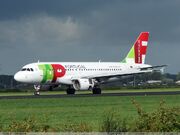As a shortened-fuselage version of Airbus’ A320 cornerstone single-aisle jetliner, the A319 continues to prove its versatility – enabling carriers around the world to benefit from the aircraft’s range options and seat layout flexibility. In addition to the standard 124-seat configuration with a range of up to 3,740 nautical miles, Airbus offers an option with a seating capacity of up to 156 passengers – a version that is being ordered by an increasing number of low-cost airlines.
The A319 has the same optimised cabin cross-section as the other A320 Family members – which is the widest single-aisle fuselage on the market and sets the standa

A319
rds for passenger cabin adaptability in this segment. This allows for top-of-the-range comfort with generous seat width, or an extra-wide aisle for fast turnarounds.
CABIN EXCELLENCE
A new cabin interior introduced by Airbus for the A320 Family ensures the A319 meets the needs of airline travellers today and tomorrow, bringing passenger comfort to a new level for its category. It provides a fresh new look, significant increase in overhead stowage, a noticeable reduction in noise, and options for ambience lighting – all with lower weight. Facilit
ating the A319’s onboard operational effectiveness is its digital cabin management system, which controls cabin-related tasks ranging from interior lighting, pre-recorded messages and emergency evacuation signalling to potable water management. It also can perform the checkout of all service units from a single point. Below the main deck, an unmatched cargo capability results from the A320 Family’s wider fuselage – enhanced by its containerised cargo loading system that is unique in its aircraft category and is compatible with the airline industry’s freight system for
wid
ebody jetliners.
PRECISION AND COMMONALITY
Advanced navigation technology developed for the A320 Family is available on the A319. The use of RNP-AR (Required Navigation Precision – Authorisation Required) procedures combined with RTA (Required Time of Arrival) operations eliminates the need for holds during a flight, and enables a continuous descent approach. The net benefits are lower noise and reduced fuel burn, as less engine thrust is required.
The A319 shares the same fly-by-wire flight controls and state-of-the-art cockpit as the other A320 Family members, profiting from the unique benefits of Airbus operational commonality. All of these aircraft – the A318, A319, A320 and A321 – share the same pilot type rating. With only minimal additional training, A320 Family-rated pilots can quickly transition to Airbus’ widebody jetliners.
